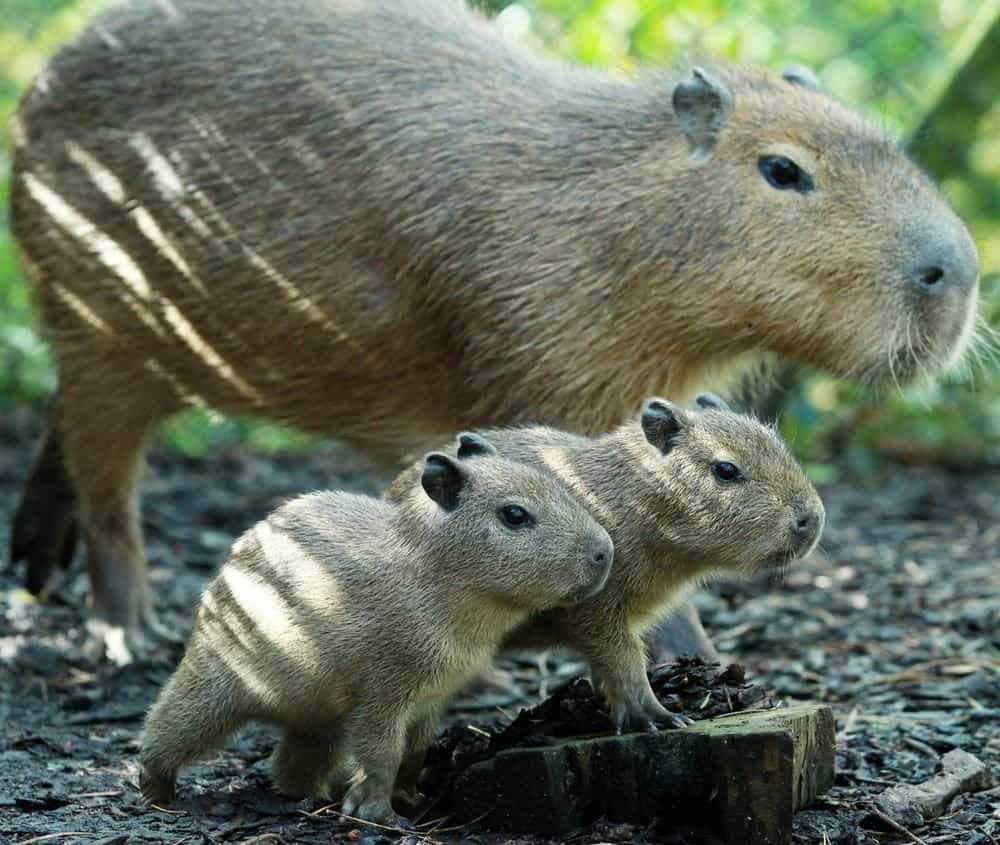In the heart of South America’s diverse ecosystems, a remarkable creature roams the wetlands and grasslands, captivating the hearts of those who encounter it – the capybara. Often referred to as the “world’s largest rodent,” these gentle giants are renowned for their social nature, aquatic prowess, and endearing personalities.
This interesting article delves into the fascinating world of capybaras, exploring their biology, behavior, habitat, conservation status, and the unique bond they share with other animals.
Meet the Capybara:
Capybaras (Hydrochoerus hydrochaeris) are the largest rodents on Earth, native to South America. They belong to the family Caviidae, which also includes guinea pigs and maras.
Adult capybaras can reach impressive sizes, weighing up to 175 pounds (80 kilograms) and measuring up to 4.5 feet (1.4 meters) in length.
Their robust bodies are covered in coarse, brownish fur, and they possess partially webbed feet, making them excellent swimmers.
A Social Species:
Capybaras are highly social animals, living in groups that can range from a few individuals to over 100 members. These groups are typically led by a dominant male, who maintains order and protects the herd.
Capybaras are known for their peaceful and cooperative nature, often seen grooming each other, playing together, and even sharing food.
Aquatic Adaptability:
Capybaras are semi-aquatic mammals, spending a significant portion of their lives in and around water. They are excellent swimmers and divers, capable of holding their breath for up to five minutes.
Their webbed feet and streamlined bodies help them navigate through water with ease, while their eyes, ears, and nostrils are positioned high on their heads, allowing them to see and breathe while submerged.
Habitat and Distribution:
Capybaras are found in various habitats throughout South America, including savannas, grasslands, forests, and wetlands. They are particularly fond of areas near rivers, lakes, and ponds, where they can graze on aquatic plants, grasses, and fruits.
Capybaras are widely distributed across their range, but their populations are threatened in some areas due to habitat loss and hunting.
| Feature | Description |
|---|---|
| Geographic Range: | South America, east of the Andes Mountains, from Panama to northern Argentina and Uruguay |
| Preferred Habitats: | – Riparian zones (areas along rivers, streams, and lakes) – Wetlands, marshes, swamps – Flooded grasslands and savannas <br> – Dense vegetation near water sources |
| Habitat Requirements: | – Access to freshwater for drinking, swimming, and thermoregulation – Abundant vegetation for grazing – Dense cover for hiding from predators |
| Seasonal Variation: | – During the wet season, capybaras may disperse into flooded grasslands. – During the dry season, they tend to concentrate near permanent water sources. |
| Adaptations: | – Partially webbed feet for swimming – Eyes, ears, and nostrils positioned high on the head for observation while submerged – Thick fur for insulation and buoyancy |
| Conservation Status: | Least Concern (IUCN Red List), but populations are threatened in some areas due to habitat loss and hunting |
| Threats to Habitat: | – Deforestation – Agricultural expansion – Urban development – Pollution of water sources |
Diet and Feeding Habits:
Capybaras are herbivores, primarily feeding on grasses, aquatic plants, and fruits. They are selective grazers, choosing the most nutritious parts of plants to eat.
Their diet varies depending on the season and availability of food sources. During the dry season, when food is scarce, capybaras may travel long distances in search of sustenance.
| Category | Details | Notes |
|---|---|---|
| Dietary Type | Herbivore (Primarily Graminivore) | Capybaras mainly eat grasses and aquatic plants. |
| Daily Intake | Up to 8 pounds (3.6 kg) of vegetation | This amount can vary depending on the size of the capybara and the availability of food. |
| Feeding Time | Most active at dawn and dusk | This is when they are most likely to graze and forage for food. |
| Preferred Foods | Grasses (e.g., Panicum, Axonopus) <br> Aquatic Plants (e.g., reeds, water hyacinth) <br> Tree Bark <br> Fruits and vegetables (when available) | Their diet can vary depending on the season and habitat. |
| Coprophagy | Yes | Capybaras eat their own feces to help digest cellulose in their diet. |
| Digestion | Hindgut fermentation | Similar to horses and rabbits, they have a large cecum where bacteria break down plant material. |
| Teeth | Continuously growing incisors and molars | Their teeth are adapted for grinding tough plant material. |
Conservation Status:
While capybaras are not currently considered endangered, their populations are facing threats from habitat loss, hunting, and human encroachment. Conservation efforts are underway to protect their habitats and ensure the long-term survival of these gentle giants.
The Capybara’s Unique Friendships:
One of the most endearing aspects of capybaras is their ability to coexist peacefully with a variety of other animals. They are often seen sharing their space with birds, monkeys, turtles, and even crocodiles.
This unique bond demonstrates the capybara’s gentle nature and adaptability, as well as the interconnectedness of life in their ecosystems.
Conclusion:
Capybaras are a testament to the diversity and wonder of the natural world. Their social nature, aquatic prowess, and endearing personalities have captured the hearts of people worldwide. As we continue to learn more about these gentle giants, it is crucial that we take steps to protect their habitats and ensure their continued existence for future generations to admire and appreciate.
Originally posted 2024-06-06 09:24:52.





kapipara very love, i love it
Bộ trưởng bộ ngoại giao gọi tên capybaras
Máy lạnh tủ đứng , âm trần LG luôn là sự lựa chọn hoàn hảo cho mọi nhà